Princess Mononoke is celebrating its 20th Anniversary this year. Personally, I consider it Miyazaki’s masterpiece, beyond even Kiki’s Delivery Service, My Neighbor Totoro, and Spirited Away. Since the film has been re-released in a few theaters, I want to look back at the movie, and talk about what I think is the most remarkable aspect of a remarkable film.
Princess Mononoke was not a sure bet. Miyazaki hadn’t made a truly serious film since Nausicaä of the Valley of the Wind back in 1984, and most of his studio’s movies were aimed at children. But Miyazaki looked back at early sketches he’d done in the 1970s, that featured a girl married off to a monster, and felt the need to make a film about the battle between civilization and wilderness. He created a male protagonist, and axed his monster (it looked a lot like the Totoro’s friend the Catbus) and decided that the princess herself would be the monster. Over two years he pulled a film together at a pace that can only be considered heroic—out of the 144,000 cels created, Miyazaki personally redrew over 80,000. The film that emerged was complex, ambiguous, and definitely not for small children. It delved into Japan’s past, offering a look at people on the cusp of modernity, and portraying pre-modern Japan was far more diverse than previously traditional depictions.
Miyazaki takes what appears at first to be a simple quest story and twists it into a giant, multi-faceted ecological commentary. Ashitaka, a young Prince of the Emishi, is cursed by a boar-god and sets out to learn what turned the boar into a demon. He leaves his village, the oracle Lady Hii, and a girl named Kaya. He soon learns that his cursed arm has superstrength, but he knows that the curse will gradually eat into his soul and give him an agonizing death. He meets a monk/conman named Jigo, and ends up in Tataraba, Iron Town, where the boar-god was killed. He rescues two of the townfolk, catches a glimpse of San, the adopted daughter of Moro the wolf-god, and befriends the Kodama, mischievous forest sprites. Initially taking the gods’ side, he hates Lady Eboshi, the boss of Tataraba, and finds himself entangled between her, San, Moro, a second boar-god, a lord named Asano, and eventually Jigo.

San and the gods revere the supreme Forest Spirit, Shishigami, and want to drive the humans away from the ancient forest. Jigo wants Shishi’s head, and has asked Lady Eboshi to get it for him. Lord Asano wants Lady Eboshi and her town full of meddlesome women under his command. And what does Ashitaka want? He wants to do as Hii-san has asked, and “see with eyes unclouded by hate.”
To say it paid off seems almost like a joke. Between the movie’s Japanese premiere in July 1997, and the following November, the movie was seen by twelve million people—about one tenth of Japan’s population at the time. When the film came to video, there were reports that 20% of the sales were to people who had never bought a video before. Two years later, long after it had been established as a hit, and you could easily rent or buy a copy, a Friday evening broadcast of Princess Mononoke earned a 35% share of the night’s TV ratings. While it wasn’t nominated for an Oscar in the U.S., it was the first animated feature film to win Best Picture in the Japan Academy Prize.
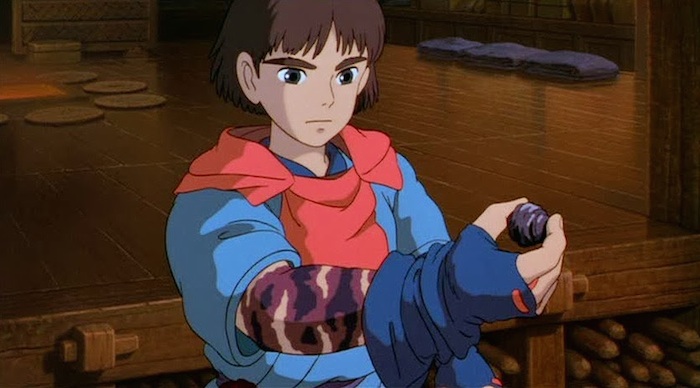
It’s interesting to look back at the American reviews for the English language release in October of 1999. Many reviewers are trying to wrap their heads around an animated film that’s not for kids. Several focus on the Japanese-ness of the film, and try out the word “anime” (you can hear them sounding it out as they type) and then they compare the film to either Otomo’s Akira or the work of Akira Kurosawa, take a bow, and call it a day. Only Roger Ebert seemed to understand that he has seen a masterpiece.
And looking back at those early reviews, no one makes any mention of the English screenplay, written by this obscure author named Neil Gaiman. I had already seen the film by then—I was lucky enough to see a bootleg subtitled version of it about a year before it came to U.S. theaters, but I was on board for the dub as soon as I learned Miramax hired Gaiman to write it, since I’d also been turned on to Sandman a few years earlier. In 1999, however, Gaiman was barely a cult figure in the U.S., and it wasn’t until a year later that American Gods came out and put him on more readers’ radars.

But back to the film itself. You can see Miyazaki’s concerns play out in the character triangle he creates, and the triangle he sidesteps.
In the subtitled version I saw, a village girl named Kaya runs out to say goodbye to Ashitaka, even though, as he’s been declared dead, she breaks a huge taboo in doing so. The relationship between Ashitaka and Kaya is left ambiguous. She gives him a crystal dagger and promises to think of him, and he says he won’t forget her. With no further village scenes, we have no way to know whether it was bold for a girl to give a young man a gift, or if the two were betrothed, or if they’re just good friends. To me, the scene reads as a young couple reluctantly saying goodbye. Later, when Ashitaka wants to declare his love to San, he gives her Kaya’s dagger. She adds it to her necklace of teeth. But in the official Westernized Disney script, Kaya refers to Ashitaka explicitly as her brother, and he says, “How could I ever forget my little sister.” This completely changes the context of the gift, and now when Ashitaka passes the dagger to San, he’s giving her a family heirloom, not his ex’s jewelry. Talking about the scripting process for the tenth anniversary, Gaiman implied that that wasn’t his change:
Every once in awhile, there are little bits where I go, “How did that happen? I don’t get it.” I was asking them last night, “Why did the little girl in the village become explicitly his [Ashitaka’s] sister? I didn’t think she was in the script they gave me, and she certainly wasn’t in the script I wrote.” And nobody seemed to know where that had come from.
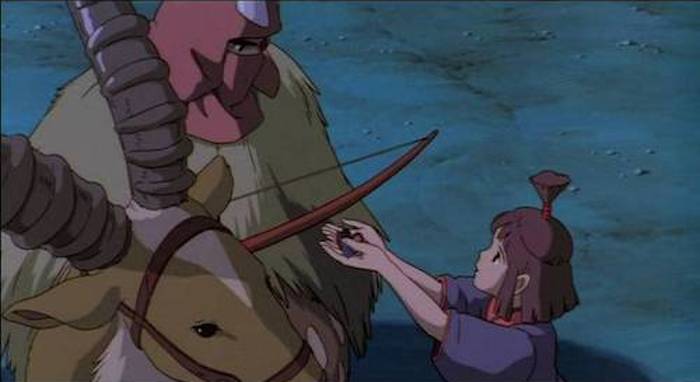
This certainly changes the relationship. My assumption is that Miramax, and later Disney, were spooked by the idea of Ashitaka leaving his girlfriend, and then giving said girlfriend’s prized possession to his new squeeze. Western audiences would probably be distracted by Kaya, and expect the film to adhere to a “love conquers all” plot, in which Ashitaka and Kaya are reunited and conventions be damned.
But no, Miyazaki leaves his convention-damning for a different emotional triangle.
Ashitaka is a member of the Emishi, an aboriginal people who lived in northern Honshu (the big island of Japan) and were mostly (and violently) pressed into submission by the Japanese by the 10th Century C.E. San is a fantastical version of a Jomon woman, the indigenous people of Japan who had died out by 300 BCE, and are possibly the ancestors of the Emishi. These two crash into the old gods, who have regarded humans as little more than a nuisance until recently, and the much more modern—and much more Japanese—Lady Eboshi.
As I watched Princess Mononoke for the first time, I remember being so viscerally on San’s side during her first attack on the village. When her knife clashed with Lady Eboshi’s I felt it in my chest – two women fighting, and thrilling in their fight, as the male hero looks on. Two different viewpoints crashing into each other. And I knew whose side I was on: I wanted San to tear Lady Eboshi’s flesh right off of her bones.
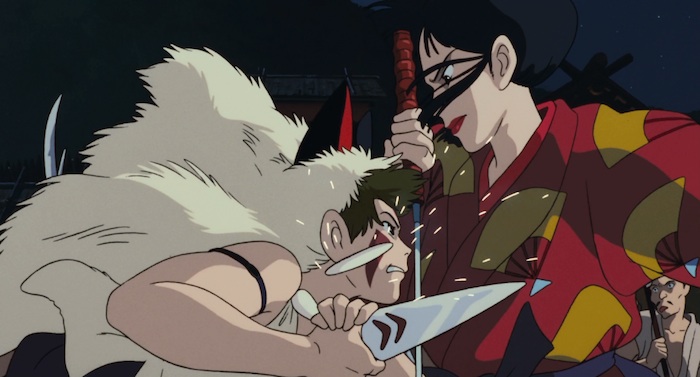
I hated Lady Eboshi. I have rarely hated any fictional character so strongly. Everything she was doing disgusted me, and because this was a Japanese film, set against an ancient culture, I was able to drop any preconceived notions and barriers and experience the film in a way I rarely have.
But then, inevitably, I saw how she cared for her people. I saw how she rejected the Emperor as weak and useless, and championed the working-class. I saw how she opened her arms to people cast off by society. I saw how she was willing to kill the gods themselves to give humanity a better future.
She certainly sees gender lines. She holds the men and women of her town to separate jobs. She has recruited her women from brothels—gendered, sexual work—and holds secret meetings to remind them not to trust men. For all of her own strength and personal power, she allows herself to be used by a male monk, which leads to the destruction of her town, and, maybe most telling, she is never seen without makeup. Her lips are a red slash at all times, creating a pleasing face—for herself? The men? The women?—and providing a counterpoint to San’s first appearance, when the girl’s mouth is red with her mother’s blood. Eboshi has bought her women’s freedom and trained her women to shoot, but she has also locked everyone into a rigid life that cannot bring true equality or freedom.
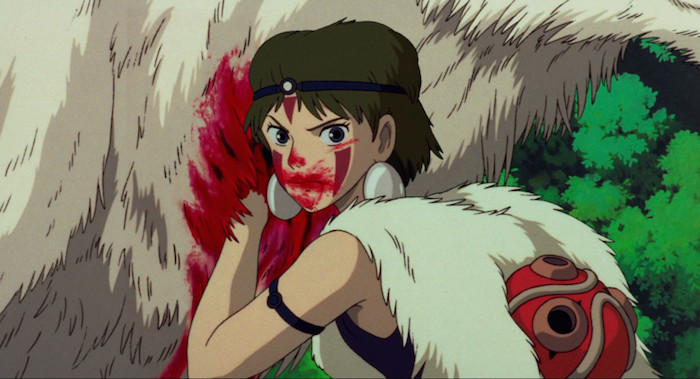
In the opposite corner we have San. Looked at from a certain angle, San is also a Disney princess. San is a monster princess, not by birth but by adoption. Her parents threw her at Moro’s feet, sacrificing her to save their own lives. Rather than eating the infant, Moro chose to raise her, and she proved herself worthy of life in the pack. If she had shown weakness Moro would have killed her in the same way she threatens to kill Ashitaka, not out of hatred but purely for efficiency’s sake.
San knows her cause is doomed, but she fights anyway. She knows what her mother’s blood tastes like. She nearly becomes a demon, loses her mother and her home, and in the end feels the burning of Ashitaka’s curse when the demon-didaribotchi touches her. She has more reason than ever to hate humanity. But even after that, she’s the one who saves Eboshi. By the end of the film, she even allows herself to love Ashitaka, without allowing humanity to change her essential nature.
Where Ashitaka transcends the two women, and finally becomes the hero of the film, is in his respect for all life. When he comes to Iron Town he hates Lady Eboshi, and with good reason, but he listens to her. He sits with the men in their quarters and listens to their stories, then he goes to bellows to visit the women and help them with their work. In Iron Town the work is divided along gender lines, but Ashitaka simply ignores them: he helps the women with the bellows not to belittle them, but to give them a break from work that he recognizes as difficult; he treats Lady Eboshi with respect despite his anger; and he speaks to the lepers without fear or revulsion. His relationship with Yakul is one of equals, and he treats all the god-animals with deference rather than hatred or fear. He even asks the Kodama for permission before walking through their forest, a politeness which is rewarded when they lead him to the healing waters of the pool. Ashitaka sees all sides, and since he’s approaching the fight from a place of empathy, and a real desire for understanding, he’s able finally to broker peace between them all.
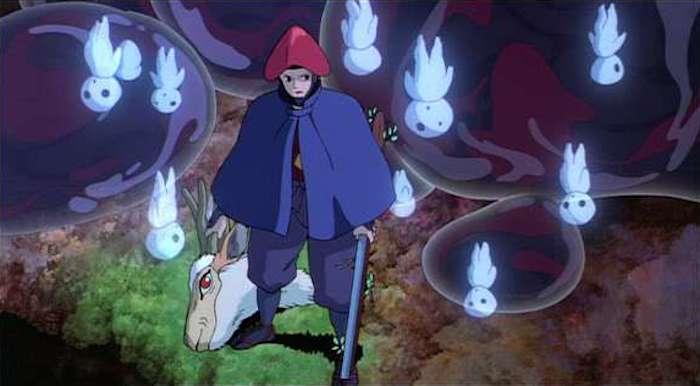
At the end of the film, San and Ashitaka lose their fight. The two people you’ve been rooting for fail, and Lady Eboshi kills Shishigami. But the film doesn’t just end there, because actions have consequences.
Does Shishigami simply grow a new head, smile, and prove that deity trumps humanity?
No.
The Forest Spirit is truly dead, and his body becomes a horrifying black ooze, killing everything it touches. What sentience is left to the monster becomes obsessed with one thing: reclaiming its stolen head. Eboshi, victorious and unafraid, is mauled by Moro’s corpse and loses an arm. Does she bleed to death on the ground, decrying her foolishness? No. Ashitaka binds her wound, and San and her wolf brothers to carry her to safety. She has acted stupidly but her life is still precious, and Ashitaka has promised the villagers he’d save her.
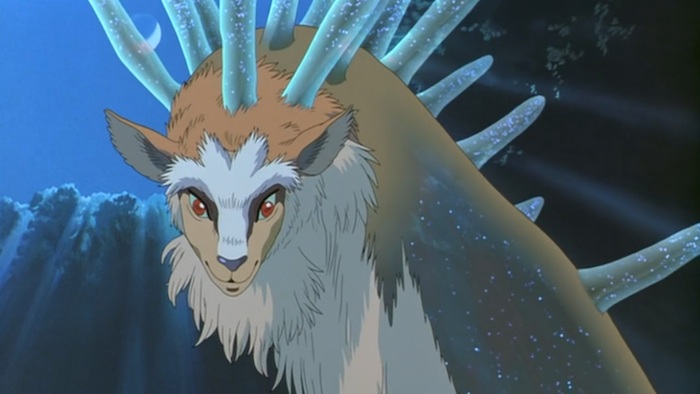
Jigo absconds with the head, and Ashitaka and San pursue him. Does Ashitaka end the film with an epic battle with the monk, killing him?
No.
First of all, Jigo turns out to be a much better fighter than you’d expect. But more importantly, Ashitaka reasons with him, going so far as to beg him not to take a violent path.
Jigo says that if they just wait for sunrise, the demon-Didaribotchi with disappear like a bad dream. This is probably true—the monk’s been right about everything else. But Ashitaka knows that though this is the easier path, it isn’t the right one. Shishigami deserves to die, if he must die, in dignity. To allow him to fade away in his demon form will curse the countryside.
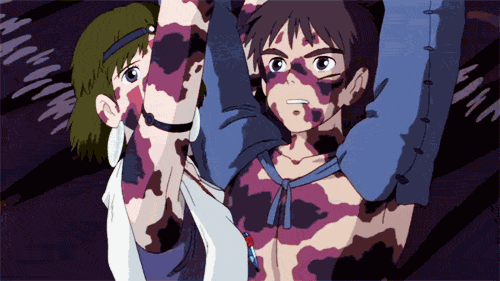
In the end Jigo gives up, and Ashitaka and San return the head. Shishigami is restored just as the sun comes up. And what happens then? Does the forest suddenly sprout? Does Shishigami shake off his wound and go back to normal?
Of course not.
He’s dead, in the way gods can die when humans defeat them, but he’s also still alive, in the way that his spirit infuses the countryside. His body falls right over Iron Town, and his spirit rolls out over the lake and countryside like an atomic blast. Ashitaka and San are healed, but not just them – so are the lepers and the war-wounded. As we watch, the blighted land becomes green, and flowers even begin to sprout. The Great Forest will never again be what it was, but Ashitaka and San’s act of reverence has healed the land.
Do San and Ashitaka live happily ever after?
Not exactly.
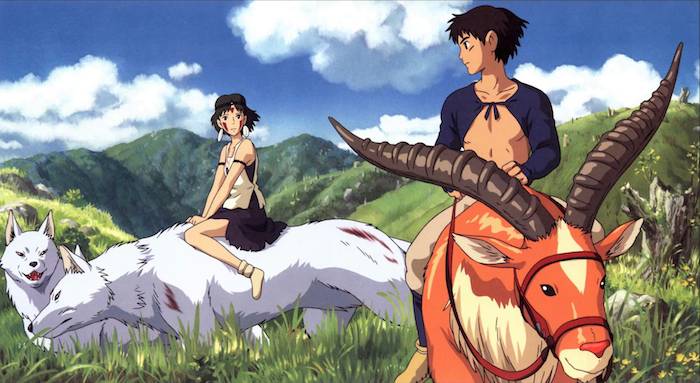
Ashitaka is a human, and he loves the people of Tataraba, but San will never forgive them for the murder of Shishigami. So, in what may be the healthiest romantic resolution of any film in history, Ashitaka decides to live in the village and help his friends rebuild. San will go back to what’s left of the forest, and restore order with her wolf-brothers. They’ll live their separate lives, and Ashitaka will come into the forest when he can to visit. Change is inescapable, and much has been lost, but the pair doesn’t give up on their love simply because it’s difficult—they create a new path that will make it possible.
Each character, by letting go of their own hatred and short-sightedness, is able to rebuild a life in a new world.
Leah Schnelbach is going to spend all day watching Studio Ghibli films. You can bug her on Twitter!










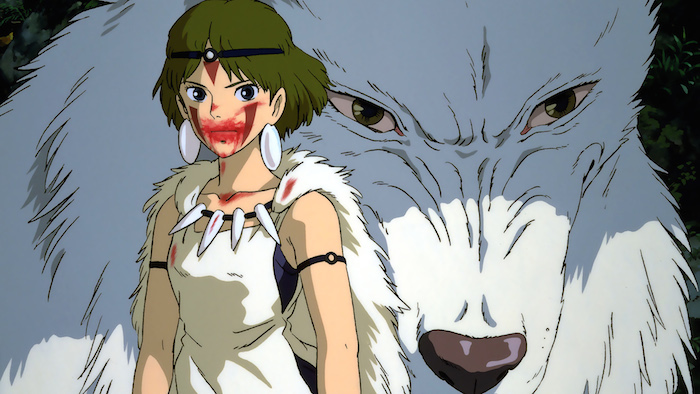
Miyazaki had been very wary for years about releasing his films in the US after his experience with the US distribution of NAUSICAA. That film had been severely edited, with several scenes transposed, and released under the title “Warriors of the Wind,” ultimately bearing little resemblance to the original film.
It’s said that, keeping this in mind, after Miyazaki signed the agreement with Disney, he then sent the team preparing the film for US release a package containing a samurai sword with a note attached reading “No Cuts.”
I thought of some words to describe how much I love this movie. I found none good enough. This was a first for me in many ways: first Myiazaki, first non-Disney or cartoon animated movie, first non-cliché plot/ending… it was like something from completely another world, and watching it for the first time was a life-changing experience.
Thanks for this article, it gave me tons of feels and nostalgia… and also plans for this evening.
What a cool evening this has been. Just finished watching a great youtube lecture on one of my favorite films, Dark City only to come over here and read a great review of one of my other all time favorite films.
Another defiance of convention in this movie that sticks in my mind: early on, when Ashitaka first meets Jigo, the scene that happens plays out very much as “meeting the comic relief sidekick”. Then Ashitaka just up and leaves, and Jigo’s role becomes utterly different.
@@@@@ wingracer. Oooh what was the Dark City video called? Link please.
Oh man oh man. This was as many have said – one of their first animes and as it was for me – it brought me into the world of anime and I’ve never left. Miyazaki is the gold standard for what animes can be and just for what films can be – something that truly transcends the medium.
@ChocolateRob
This guy does long series of video game walkthroughs but about the last 1/3rd of each video is a little lecture on some related piece of film, literature, science or history, etc. My favorite is his series on the original Deus Ex but now he’s on to the sequel, Deus Ex Human Revolution. If you don’t care about the playthrough, just skip ahead.
https://www.youtube.com/watch?v=dIR6isxycio
@@@@@ wingracer Bloo… erm, Blinking Heckers! I didn’t know that about the real Schrieber’s father, that’s terrifying…
thanks for the link.
PS Sorry Leah for Hijacking your Princess Mononoke article to discuss Dark City.
Yeah, that guy does his research for his little lectures and then buries them at the end of playthroughs that only a few hardcore gamers would ever watch. I wish he would do a whole channel of just his film, literature and history lectures. They are fantastic.
As for hijacking, I suspect there is a fair amount of crossover in fans of both films despite being very, very different.
My first anime was actually Warriors of the Wind – and despite its cuts and warping, it set me on a quest to find more. Found the full Nausicaa – but undubbed/not subtitled, and I wasn’t quite hooked enough to learn Japanese just for that. Though I watched it anyway. Got the (English) manga, the Perfect Collection, and finally found a good English-dubbed version. At which point I figured out the creator had more movies!
Princess Mononoke was my second Miyazaki (not my second anime, I’d seen some others), and my second favorite of his. So rich. I just rewatched it recently. I love your descriptions and review. I like other Miyazakis, but these two are in a class of their own.
Excellent analysis! Don’t forget the magical score by Joe Hisaishi! To me it completes the lushness of the film.
In 2000, before Miramax released the DVD, the Internet email list Nausicaa.net gathered signatures on a petition to include the Japanese track on the disc. The emails were printed out and presented to an executive at a breakfast meeting at Anime Expo which was held at the Disneyland Hotel that year. I was lucky enough to attend. I don’t know if the petition actually changed their mind, but there was a Japanese track when the DVD was released in the US.
Very well written and hopefully will help my parents who were not at all impressed with the film understand what make it so different and so much better than Western shows that are marketed to children. I agree this is likely one of his best shows – though Naussica is a close second.
Many years ago my son introduced me to not only the brilliance of Miyazaki and Princess Monon Okey. Besides the DVD, I was also presented with a silk scroll that is still one of my most treasured possessions. While the dubbed version may be more popular with most American audiences, we preferred the subtitled and have watched it innumerable times. The artistry and inherent story remain our utmost favorite of all the master’s films.
Kaya calls Ashitaka “ani sama” in the original version.
Regardless of the fact it can sometimes used as a mark of respect, it still mean “older brother” and the way they both interract and the language they use don’t particularly imply anything other than a sibling relationship. So my guess would be that the scrip Gaiman received had a mistake in it, not the other way around.
A film which is above praise, but certainly worth such an enlightening analysis as yours. Thanks from Paris.
While Ashitaka is possibly closer to a traditional righteous hero than any other character in a Miyazaki film, both San and Lady Eboshi appear to me as supremely unconventional, therefore unforgettable characters.
A “monster princess” such as San – not a nice sweet princess temporarily transformed into a monster by a wicked sorcerer, but a self-assuming defender of those beings considered as monsters by mankind and as brethren by her – is certainly quite alien to Western fairy tales. I wonder if it has any source in the Japanese folk tradition. Superficially common features with the Jungle Book, but in a radically different perspective.
As to Lady Eboshi, she should have been the villain of the story if it had just been a simplistic fable on Man (actually Woman, unusual enough in itself) Destroying Nature. But she has so many other positive traits that clearly Miyazaki gives her a very fair treatment. Be that as it may, I cannot remember having seen any classic Japanese film, especially an historical one, where a woman (noble? or more probably commoner, despite the Lady title of respect?) appeared in such a strong position, as a community-leader openly despising and rejecting conventional patriarchal codes.
Why is there a .gif of San copping a feel?
I can’t say that there are any anime or disney sort of movies who are in my top ten list, but this one somehow did it. I can’t describe at all how I was deeply sucked in. Truly nonconventional characters and plot and ending. As said above it was a different world altogether. Nothing like it in western culture, japanes culture has a higher definition of noble that few can compete with and it has such a strong appeal. I am left speechless by this pure and noble scenery. and yes the music was… as well otherworldly.
thanks Leah for reminding me with this great review.
On Kaya. Ashitaka and Kaya are not siblings. From what my Japanese wife said, Gaiman’s interpretation is correct, and the interpretation of the meaning of the gift as witness of an unchanging heart is also correct correct; Kaya is Ashitaka’s betrothed.
That’s an amazing writeup! Ashitaka’s unconventional heroics turn on a crucial trait of his, spelled out in the bidding of the wise woman: he can “See with eyes unclouded”. He appears as a typical action hero in the first few minutes but then throughout the film never lets hate or anger overcome him, and never sees any of his adversaries as any less than a human.
It’s truly a rare commodity in the modern world with its total dehumanization of the opponent, or maybe in the human race generally. Perhaps Miyazaki may have felt it, too, at least I can’t remember any character quite so perfect in this regard in his later works.
I came here through a random link on Twitter. Thank you for reminding me of the tragic beauty of this masterpiece, I know what I’ll do on the second Saturday of 2020.
Thank you Leah
To be frank, the female characters of Iron Town, such as Toki and Eboshi, are just a bunch of misandrists who openly mock and ridicule men cruelly and sadistically. That is fact which is clearly evident.
Toki even had the guts to say to her husband that he should have died so that she can get a new husband. Give any excuse you want, but anyone with basic decency will find that off-putting.